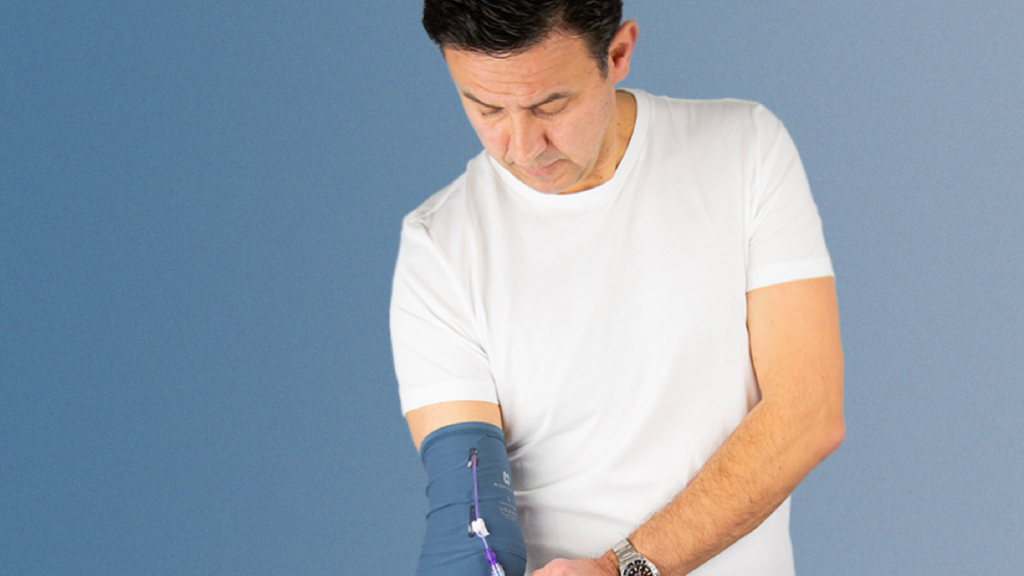Getting a PICC (Peripheral Inserted Central Catheter) placed comes with many unknowns: How will it feel to have a tube inside my body? Will the procedure hurt? What is the procedure like? What are my options for PICC securement? The team at Mighty Well has been there, and we know that having the right information and products available is key!
We recently partnered with the Association for Vascular Access to put together the Ultimate Guide to PICCs, which you can download for free here, or check out the video version at the end of this post! It covers concerns you may have before getting a PICC line, what to expect during the procedure, how to care for a PICC line, and complications to watch out for. Patients frequently ask about how to keep their PICC lines secure. There are a few options for PICC securement available:
1. Sutures
In the past, PICCs were held in place with stitches, which are commonly referred to as ‘sutures’. While effective at keeping things from moving around, stitches are not favored by the clinicians at the Association for Vascular Access because they can cause additional problems. The insertion site can get infected, or the sutures could fall out. Talk to your clinician about alternative options of securement.
2. Grip-Lok
Adhesive products are now more frequently used to keep insertion sites secure and protected. Grip-Lok Securement Devices are hypoallergenic and use a hook-and-loop design so that they can be adjusted without removing the adhesive. This is a type of Engineered Stabilization Device (ESD).
3. SecurAcath
Another innovative product – SecurAcath – is placed into the insertion site, just under the skin. It does not create new holes in the skin for potential infection like stitches and does not have to be removed or replaced until the PICC itself is removed! It also does not irritate the skin the way that both stitches and adhesives sometimes do. This is a type of Engineered Stabilization Device (ESD). Mighty Well is a big fan of this option where and when it is available for patients!

4. PICC Line Covers
Whatever your care team uses to secure the PICC, also known as an Engineered Stabilization Device (ESD), you could also want a PICC Line Cover to be used in conjunction with ESD for added comfort and protection. PICCs and securement devices can get snagged or pulled on during dressing changes and daily activities. PICCPerfect® PICC Line Covers keep everything in place and prevent dressing adhesives from peeling prematurly. They keep dirt and germs off the insertion site and are antimicrobial for additional protection against infection. The double-layer design also prevents irritation by keeping the lumens off your skin.
Your comfort and safety matter! Feel free to ask your care team ahead of time what securement devices they plan to use. If you have a concern, it is best to ask for other options in advance so that you can feel confident on the day of your procedure.
5. Garment Based Catheter Securement Sleeves
Similar to PICC Line Covers, Garment Based Catheter Securement Sleeves like PICCPerfect® Pro are designed to protect PICCs. These are FDA Registered medical devices that have been shown to add benefits to patients and clinicans in the following ways:
Improved dressing integrity and reduced dressing changes:
In the control group, clinicians reported frequently encountering:
- Unscheduled dressing changes
- Rolling dressing edges
- Patients picking at their dressing edges
- Dressing edges lifting on average on day 3 after dressing placement
Within the intervention group, clinicians reported:
- Improved dressing integrity
- Prolonging the dressing lifespan to a 7-day duration using an occlusive dressing.
- Reduced nursing workload and cost by eliminating the need for unscheduled dressing changes
Ask your doctor if they prescribe the PICCPerfect® Pro – click here to learn more or to share it with your care team. PICCPerfect® Pro can also be purchased by patients or caregivers directly here.
We wish you good luck and healing on your PICC journey! Curious in learning more? Watch the video below or check out Mighty Well’s Educational Hub for more information on caring for your PICC:
Got more questions about PICCs or Ports? Check out our Educational Hub for more information.

